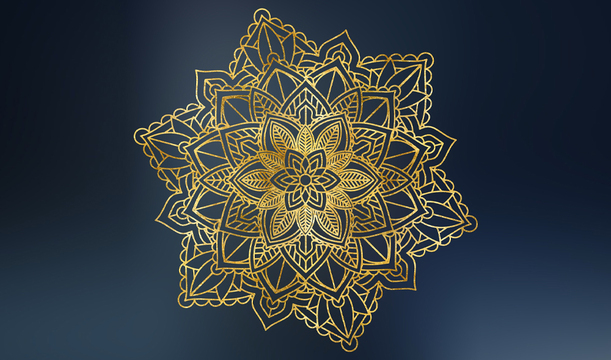What is the mandala? The key to understanding you

A mandala can take so many different forms that it would be impossible to list them all. In fact, you've probably interacted with mandalas in the past without even realizing it. These geometric shapes appear on ancient temples, texts and works of art. But what is a mandala? To understand the meaning of the mandala, you must be willing to gain a deeper understanding of yourself. We will explore these concepts as we delve deeper into the true nature of these incredible patterns.
What is a mandala?
Let's start from the basics: what is a mandala? The term can be used to mean slightly different things, but let's start with the first versions. The first mandalas began to appear during the first century BC when the term appeared in Rigveda. We find that early Vedic rituals and Buddhist temples would create mandalas using a specific shape: the shape would be a square with 4 doors, and within this square there would be a circle.
Since then, the term has been adapted to refer to any spiritual practice involving the drawing of a pattern or a geographical form as a representation of the universe, the cosmos, a higher power or one's self. Each mandala can mean something completely different, and while some have general meanings, they are largely considered an individual practice often used to focus the mind. Creating one is not unlike meditation, in that your mind becomes free of thoughts by focusing on a single activity or action.
Mandala Meaning
Understanding the meaning of the mandala is a slightly more complicated task than understanding what they are. Each can represent something completely unique, yet they are all connected by a similar sequence of consciousness. In a sense, a mandala represents connection, unity, peace, harmony and integrity. These are the energies that are put into every model and form during its creation. At the same time, each still carries its own unique meaning and message.
Due to the ancient nature of these geometric connections with the universe, there are a number of different aspects that everyone could cover. We discover that they can represent a religion and a religious belief, different types of meditation, cosmic order and being, psychological and emotional balance, peace and harmony, the cyclical nature of life and the universe, the numbers of angels and even the concept of God .
Different groups of people will perform this practice for a different reason. For example, the pagan Celts would have created the Celtic cross, which is a type of mandala. For them, it would represent the three states of being: mind, body and soul.
This pattern is also found in the Nordic regions used by the Vikings and has since become a symbol used by Christianity to represent the Holy Trinity. The monks of Buddhism and other faiths will use mandala creation as a way of meditating. In the meantime, Muslims will demonstrate their devotion to Allah, Islam or a specific ideal through this spiritual practice.
We now have a better understanding of the complex meaning of the mandala, but let's explore some of the more specific types that exist in the world today.
Types of mandalas
While each mandala may have a different meaning or function, three main types are generally considered. We will explore each in turn before considering how you can start drawing yours!
The first type we will discuss is what it takes to teach. They are used within religious, philosophical and spiritual bodies to demonstrate the connections that each individual has with the universe. The student will be asked to create their own mandala in order to demonstrate what they have learned and allow them to practice the act in a learning environment.
The second type serves to heal. This method is based less on rigorous lessons and designs and instead allows the creator to simply follow their intuition, being guided only by feelings, emotions and spirit. This type of mandala is more meditative in nature and instills a sense of calm and tranquility in the drawer. It allows the mind, body and soul to enter a healing space.
The final type we will see is the sand mandala. This is less common than the others but it is an important part of the Buddhist tradition. Using different sand colors, the monks create a work of art on the floor, adding intricate details to an already complex geometric pattern. They are generally considered visual representations of the nature of life.
Do it yourself - Create your own mandala
When it comes to creating your own mandala, only a couple of elements are needed: a pen, pencil or brush and some paper. You can use additional tools like a ruler, a protractor, a compass, different colors and more, but you don't think they are necessary.
When you have these items, you need to prepare yourself to draw as you would for a meditation session. Find a relaxing space where you won't be disturbed, turn off any potential distractions like the phone or television and take a few deep breaths while creating a purpose.
Your purpose is why you are drawing the mandala. Are you looking for peace and harmony? Do you want to connect to the universe? Are you reaching a higher power? It can be absolutely anything except having it in mind before you start drawing.
Fold the page in half and remember that your model should ideally be symmetrical. Whatever you draw on one side of the fold should be mirrored on the other. Allow any shape or pattern to form on the page as you simply let your subconscious mind guide your actions. If you start to distract yourself from thoughts, take a break, refocus your mind and start again.